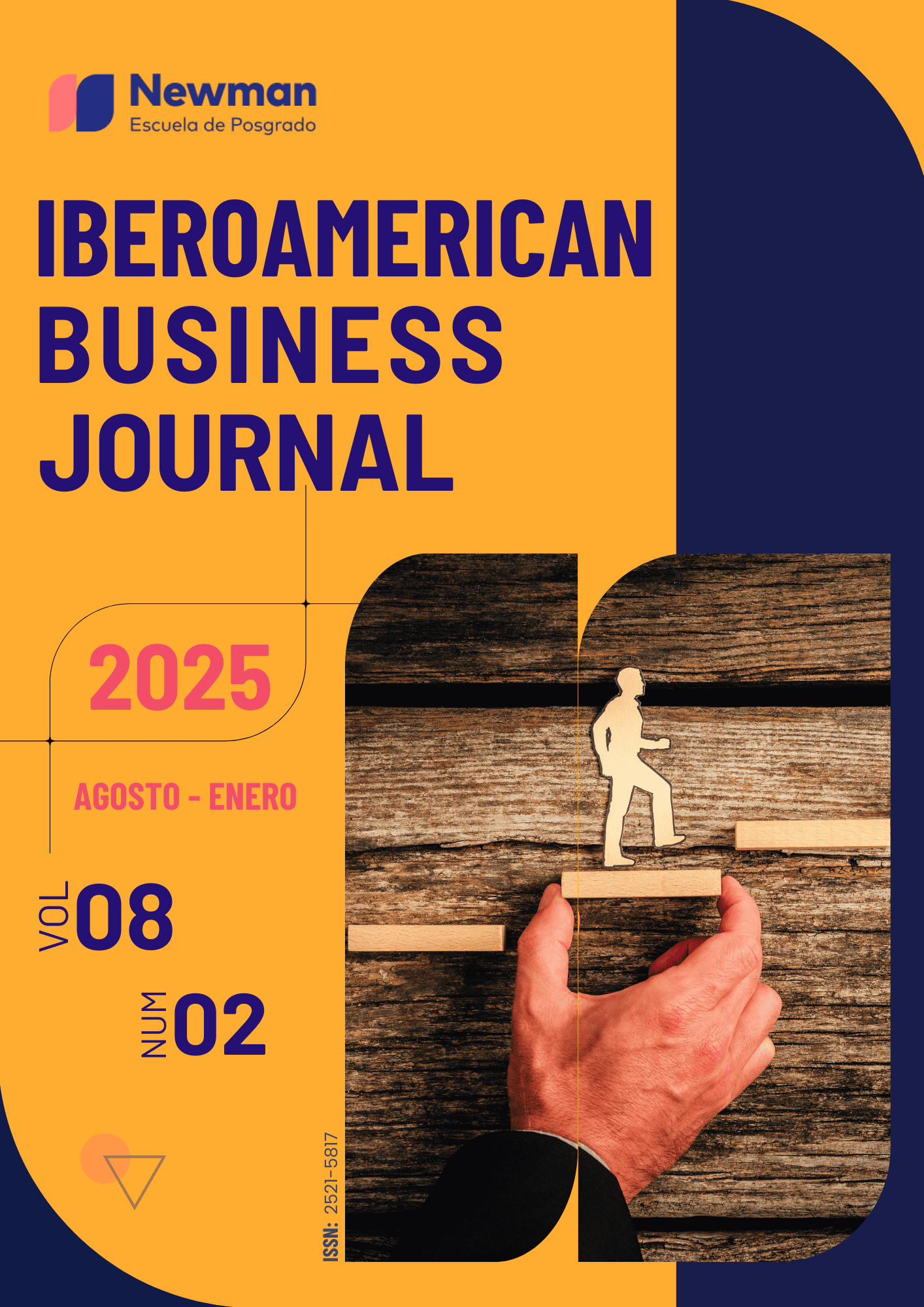Using Kanban methodology and workflow in Lima companies
DOI:
https://doi.org/10.22451/5817.ibj2025.vol8.2.11092Abstract
Objective: To determine the relationship between the use of Kanban methodology and workflow in Lima companies. Methodology: The research approached a correlational scope, non-experimental design, the survey was used as a technique to collect information on the variables and as an instrument the questionnaire that represents the tool to obtain answers. Data analysis was carried out using Excel and SPSS software, using Spearman's Rho statistical test to verify the hypotheses. Results: The data verify that 60.0% consider that the Kanban method is efficient, while 65.0% consider the workflow as adequate, it was also identified that the use of the Kanban method confirms a direct and significant link to process improvement (p=0.021; r=0.511), personnel performance (p=0.003; r=0.621), also to service improvement (p=0.001; r=0.671) with a significance of less than 0.050. Conclusion: It is demonstrated that the use of the Kanban method sustains a direct and significant link to the workflow (p=0.001; r=0.671), which confirms the hypothesis.
Downloads
References
Ahsan, M., Rizvan, R., & Ahmed, S. (2023). Implementing lean manufacturing for improvement of operational performance in a labeling and packaging plant: A case study in Bangladesh. Results in Engineering, 17, 1-14. doi:10.1016/j.rineng.2022.100818
Baker, H., Kaddumi, T., Nassar, M., & Suleiman, R. (2023). Impact of Financial Technology on Improvement of Banks’ Financial Performance. Journal Risk Financial Managment, 16(3). doi: 10.3390/jrfm16040230
Barcaui, A., & Monat, A. (2023). Who is better in project planning?Generative artificial intelligence or project managers? Project Leadership and Society, 4(3), 1-12. doi: 10.1016/j.plas.2023.100101
Cáceres, Y., Malone, A., Zeballos, E., Huamani, N., Andia, A., & Pinedo, D. (2021). Pandemic response in rural Peru: Multi-scale institutional analysis of the COVID-19 crisis. Applied Geography, 134(12), 1-9. doi:10.1016/j.apgeog.2021.102519
Candela, L., Grossi, V., Manghi, P., & Trasarti, R. (2021). A workflow language for research e-infrastructures. International Journal of Data Science and Analytics, 11, 361–376. doi: 10.1007/s41060-020-00237-x
Castellano, L. (2019). Kanban. Metodología para aumentar la eficiencia de los procesos. 3C Tecnología. Glosas de innovación aplicadas a la pyme,, 8(1), 30-41. Recuperado de: https://dialnet.unirioja.es/servlet/articulo?codigo=6866058
Chakravarthi, K., Shyamala, L., & Vaidehi, V. (2022). TOPSIS inspired cost-efficient concurrent workflow scheduling algorithm in cloud. Journal of King Saud University - Computer and Information Sciences, 34(6), 2359-2369. doi: 10.1016/j.jksuci.2020.02.006
Chmiel, W., Derkacz, J., Jedrusik, S., Mikrut, Z., & Niemiec, M. (2022). Workflow management system with smart procedures. Multimedia Tools and Applications, 81(10), 9505–9526. doi: 10.1007/s11042-021-11658-6
Dhiman, H., Nemoto, Y., Fellmann, M., & Röcker, C. (2023). Beyond productivity and efficiency: design tools, methods and frameworks for psychological well-being, and (un)exploited potentials to assist employees at work. Frontiers in Computer Science, 3(1), 1-19. doi:10.3389/fcomp.2023.1129087
Dominguez, J., Montoya, J., Bravo, M., & Paredes, A. (2023). Estrategia lúdica de aprendizaje para el control de sistemas de producción desde un enfoque Lean: El uso del sistema de tarjetas Kanban. Revista EIA, 20(40), 1-21. doi: 10.24050/reiav20i40.1672
García, J., Realycasquez, A., García, P., Pérez, M., Blanco, J., & Jiménez, E. (2019). Effects of Human Factors and Lean Techniques on Just in Time Benefits. Sustainability, 11(7), 1-20. doi: 10.3390/su11071864
González, W., & Vilchez, R. (2021). Factores del desempeño laboral del personal administrativo en universidades nacionales experimentales. Pensamiento & Gestión(51), 54-74. doi: 10.14482/pege.50.658.155
Habib, M., Rizvan, R., & Ahmed, S. (2023). Implementing lean manufacturing for improvement of operational performance in a labeling and packaging plant: A case study in Bangladesh. Results in Engineering, 17(12), 1-14. doi: 10.1016/j.rineng.2022.100818
Kristoffersen, E., Mikalef, P., Blomsma, F., & Li, J. (2021). Towards a business analytics capability for the circular economy. Technological Forecasting and Social Change, 171(12), 1-17. doi: 10.1016/j.techfore.2021.120957
Lakshmanan, R., Nyamekye, P., Virolainen, V., & Piili, H. (2023). The convergence of lean management and additive manufacturing: Case of manufacturing industries. Cleaner Engineering and Technology, 13(2), 1-12. doi: 10.1016/j.clet.2023.100620
Lameijer, B., Boer, H., & Does, R. (2023). Continuous improvement implementation models: a reconciliation and holistic metamodel. Production Planning & Control, 34(11), 1062–1081. doi:10.1080/09537287.2021.1974114
Lee, W., Lee, S., Jin, C., & Chang, H. (2021). Development of the RACI Model for Processes of the Closure Phase in Construction Programs. Sustainability, 13(4), 1-25. doi: 10.3390/su13041806
Malinova, M., Gross, S., & Mendling, J. (2022). A study into the contingencies of process improvement methods. Information Systems, 104, 1-22. https://doi.org/10.1016/j.is.2021.101880
Marques, P., Jorge, D., & Reis, J. (2022). Using Lean to Improve Operational Performance in a Retail Store and E-Commerce Service: A Portuguese Case Study. Sustainability, 14(10), 1-19. doi: 10.3390/su14105913
Mishra, A., Abdalhamid, S., Mishra, D., & Ostrovska, S. (2021). Organizational issues in embracing Agile methods: an empirical assessment. International Journal of System Assurance Engineering and Management, 12(2), 1420-1433. doi:10.1007/s13198-021-01350-1
Nadja, D., & Talib, D. (2021). An approach to optimizing kanban board workflow and shortening the project management plan. IEEE Transactions on Engineering Management, 2(1), 1-8. doi: 10.1109/TEM.2021.3120984
Pekarcikova, M., Trebuna, P., Kliment, M., & Dic, M. (2021). Solution of Bottlenecks in the Logistics Flow by Applying the Kanban Module in the Tecnomatix Plant Simulation Software. Sustainability, 13(14), 1-21. doi: 10.3390/su13147989
Senabre, E. (2019). Adapting the scrum framework for agile project management in science: case study of a distributed research initiative. Heliyon, 5(3), 1-34. doi: 10.1016/j.heliyon.2019.e01447
Shamshurin, I., & Saltz, J. (2019). Using a coach to improve team performance when the team uses a Kanban process methodology. International Journal of Information Systems and Project Management, 7(2), 61–77. doi: 10.12821/ijispm070204
Tilocca, G., Sánchez, D., & Torres, M. (2023). Application of the theory of constraints to unveil the root causes of the limited market penetration of micro gas turbine systems. Energy and Environmental Science, 278(21), 1-15. doi: 10.1016/j.energy.2023.127717
Van, M. (2021). Training, employee involvement and continuous improvement – the moderating effect of a common improvement method. Production Planning & Control, 32(2), 132-144. doi: 10.1080/09537287.2020.1716405
Vrchota, J., Rehor, P., Mariková, M., & Pech, M. (2021). Critical Success Factors of the Project Management in Relation to Industry 4.0 for Sustainability of Projects. Sustainability, 13(1), 1-19. doi: 10.3390/su13010281
Weflen, E., MacKenzie, C., & Rivero, I. (2022). An influence diagram approach to automating lead time estimation in Agile Kanban project management. Expert Systems with Applications, 18(7), 1-10. doi: 10.1016/j.eswa.2021.115866
Zheng, K., Ratwani, R., & Alder, J. (2020). Studying Workflow and Workarounds in Electronic Health Record-Supported Work to Improve Health System Performance. Ann Intern Med, 172(11), 116-122. doi: 10.7326/m19-0871
Zorrilla, F., Meléndez, I., & Rodríguez, M. (2023). Capacitación Profesional Para la Implementación de un Sistema Kanban-Tooling Para una Industria Automotriz. RIDE. Revista Iberoamericana para la Investigación y el Desarrollo Educativo, 12(26), 1-23. doi: 10.23913/ride.v13i26.1525
Published
How to Cite
Issue
Section
Categories
License
Copyright (c) 2025 Eubi Alagón Zúñiga

This work is licensed under a Creative Commons Attribution-NonCommercial-ShareAlike 4.0 International License.
Los autores que publican en esta revista están de acuerdo con los siguientes términos:
- Los autores respetan los derechos de autor y garantizan a la revista el derecho de ser la primera publicación del trabajo al igual que licenciado bajo Licencia Creative Commons Reconocimiento-NoComercial CompartirIgual 4.0, que permite a otros compartir el trabajo con un reconocimiento de la autoría del trabajo y la publicación inicial en esta revista.
- Los autores pueden establecer por separado acuerdos adicionales para la distribución no exclusiva de la versión de la obra publicada en la revista (por ejemplo situarlo en un repositorio institucional o publicarlo en un libro), con un reconocimiento de su publicación inicial en esta revista.
- Es responsabilidad de los autores obtener los permisos necesarios de las imágenes que están sujetas a derechos de autor.
- Se les comunica los autores que todos los trabajos serán subidos al programa Turnitin para comprobar su originalidad.

















